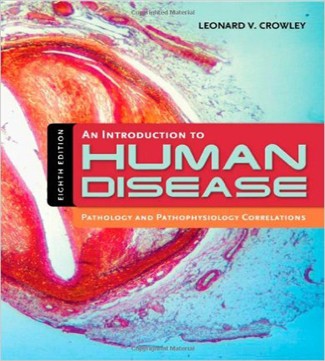An Introduction to Human Disease Pathology and Pathophysiology Correlations 8th Edition Crowley Test Bank
$35.00 Original price was: $35.00.$26.50Current price is: $26.50.
An Introduction to Human Disease Pathology and Pathophysiology Correlations 8th Edition Crowley Test Bank
This is completed downloadable of An Introduction to Human Disease Pathology and Pathophysiology Correlations 8th Edition Crowley Test Bank

Product Details:
- ISBN-10 : 0763778303
- ISBN-13 : 978-0763778309
- Author: Leonard V Crowley
An Introduction To Human Disease: Pathology And Pathophysiology Correlations, Eighth Edition Provides Students With A Clear And Well-Illustrated Explanation Of The Structural And Functional Changes Associated With Disease, The Clinical Manifestations Of Disease, And How To Determine Treatment. Ideal For Pathology, Pathophysiology, Or Human Disease Courses, The First Part Of The Text Deals With General Concepts And With Diseases Affecting The Body As A Whole. The Second Part Considers The Various Organ Systems And Their Diseases.
Table of Content:
1. A patient has a swollen ear caused by a bacterial infection. Which of the following is not a feature of the inflammatory process?
A. Leakage of fluid through permeable capillaries into the loose connective tissue of the ear
B. Congestion of tissues because of dilation of capillaries
C. Redness of skin because of increased blood flow through the inflamed tissues
D. Reduced blood flow to tissues because of vasoconstriction of capillaries in the area of inflammation
Ans: D
Page: 60
2. Which of the following is not a mediator of inflammation?
A. Prostaglandins
B. Histamine
C. Bradykinins
D. Gamma globulin antibodies
E. Products of complement activation
Ans: D
Page: 62-63
3. An infection that spreads from its original site to involve the regional lymph nodes is called what?
A. An abscess
B. Lymphadenitis
C. Cellulitis
D. Lymphangitis
Ans: B
Page: 65
4. What is the antibody-producing cell that plays an important role in protecting us from infection?
A. Plasma cell
B. T lymphocyte
C. Monocyte
D. Neutrophil
Ans: A
Page: 66, cross-reference in Chapter 5, page 77
5. Which of the following statements about pathogenic microorganisms is NOT true?
A. The ability to cause disease depends on the virulence of the organism and the integrity of the body’s immune defenses.
B. Adrenal corticosteroids facilitate destruction of organisms and promote recovery.
C. They usually incite an inflammatory response at the site of invasion.
D. The ability to respond to a pathogen is in part genetically determined.
Ans: B
Page: 63
6. A young man is struck on the cheek by a baseball and sustains an injury in which the skin is not broken and the cheekbone is not fractured. He develops an acute inflammation in the injured area. Which of the following is NOT part of the acute inflammatory process?
A. Leakage of fluid through permeable capillaries into the connective tissue of the cheek
B. Congestion of tissues caused by dilation of capillaries
C. Accumulation of leukocytes in the injured area
D. Accumulation of plasma cells and formation of immunoglobulins
Ans: D
Page: 60
7. The most important cell in the acute inflammatory response is an actively phagocytic cell called the __________.
A. mononuclear cell
B. monocyte
C. polymorphonuclear leukocyte
D. macrophage
Ans: C
Page: 60
8. Which of the following are systemic effects from an inflammatory response?
A. Elevated temperature
B. Redness and swelling
C. Blisters
D. Pus
Ans: A
Page: 60
9. These are chemical agents that are released when tissue is damaged, promoting an inflammatory response.
A. Exudate
B. Mediators of inflammation
C. Mononuclear cells
D. Vasodilators
Ans: B
Page: 62-63
10. Cells that most commonly active during chronic infections are:
A. lymphocytes, monocytes, and plasma cells.
B. polymorphonuclear leukocytes, monocytes, and mast cells.
C. complement and bradykinins.
D. None of the above.
Ans: A
Page: 66
11. What does the ending –itis indicate when it is affixed to the name of an organ or tissue (e.g., hepatitis)?
A. Pain is present in that tissue or organ.
B. An infection or an inflammatory process is occurring in that tissue or organ.
C. The tissue or organ has sustained serious and irreversible damage.
D. An abscess is present in the tissue or organ.
Ans: B
Page: 64-65
12. Injury and infection by a pathogenic organism can cause inflammation. What else can cause an inflammatory response?
A. Administration of corticosteroid hormones
B. Excess lysosomes in the cells
C. Interaction of antibodies and antigens
D. No other causes exist
Ans: C
Page: 64
13. What happens when the vasodilator histamine is released by the mast cells?
A. The inflammatory process is ended.
B. Blood platelets adhere to collagen fragments and begin the healing process.
C. Blood vessels expand and become more permeable.
D. Blood vessels constrict and become less permeable.
Ans: C
Page: 62
14. The term virulence refers to __________.
A. a disease caused by a viral pathogen
B. a disease likely to be fatal to its host
C. an organism that causes disease in humans
D. the ease with which a pathogenic organism can overcome host defenses
Ans: D
Page: 65
True/False
15. Interaction of antigen and antibody activates a series of blood proteins called complement, and products of complement activation function as mediators of inflammation.
Ans: True
Page: 63
16. Extensive destruction of tissue resulting from inflammation is often followed by scarring that may impair the function of the tissue in which the scarring has occurred.
Ans: True
Page: 62
17. Monocytes and macrophages rush to the area of cell injury at the beginning of an acute inflammation, but are not active in chronic inflammation.
Ans: False
Page: 60
18. The inflammatory reaction is the same no matter what kind of injury is present, because the injury itself does not directly cause the reaction.
Ans: True
Page:
19. The ability of the body’s defenses to fight off a pathogenic organism depends on both the virulence of the organisms and the resistance of the infected person.
Ans: True
Page: 65
People Also Search:
an introduction to human disease pathology and pathophysiology correlations
an introduction to human disease pathology and pathophysiology correlations 8th edition
an introduction to human disease pathology and pathophysiology correlations download scribd
an introduction to human disease pathology and pathophysiology correlations testbank download pdf











